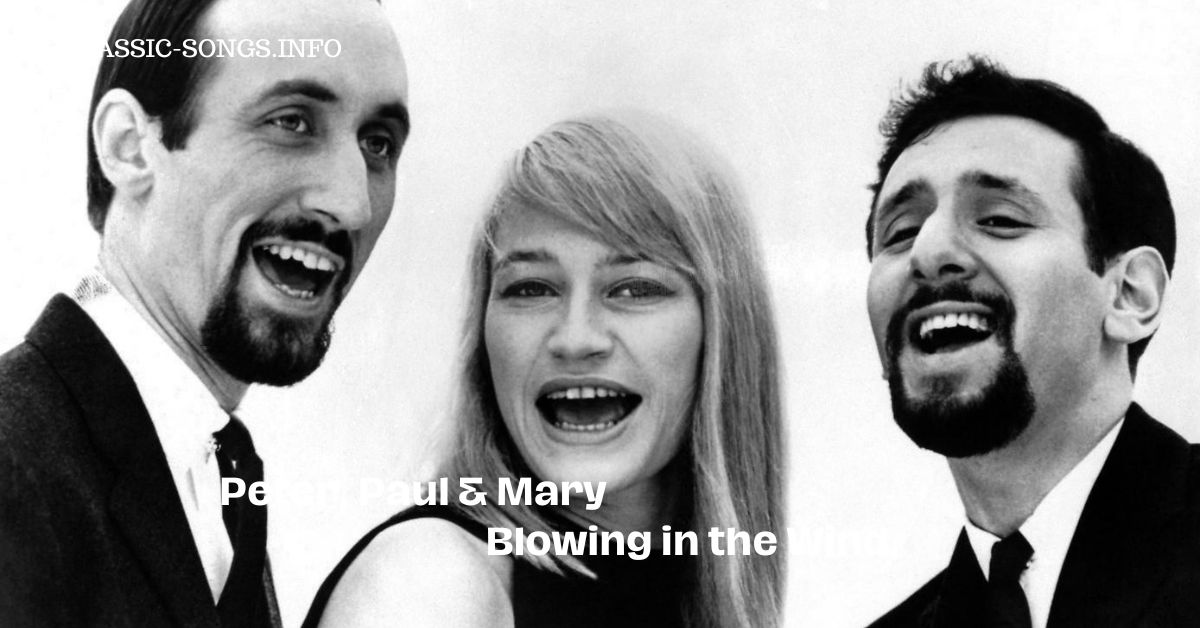About the song
Peter, Paul & Mary‘s rendition of “Blowin’ in the Wind” is a defining moment in the folk music revival of the 1960s and a landmark recording in the career of this influential trio. Released in 1963, this version of the song showcases the group’s harmonious blend of voices and their commitment to socially and politically relevant music.
Originally written and recorded by Bob Dylan, “Blowin’ in the Wind” was released on his 1963 album The Freewheelin’ Bob Dylan. The song’s lyrics are poignant and evocative, posing a series of rhetorical questions about peace, freedom, and justice. Its simple, yet profound verses reflect the turbulence of the era and the quest for civil rights and social change.
Peter, Paul & Mary’s cover of “Blowin’ in the Wind” brought the song to a broader audience, highlighting their distinctive vocal style and arranging skills. The trio—Peter Yarrow, Paul Stookey, and Mary Travers—was known for their close harmonies and folk-inspired arrangements, which they applied to Dylan’s composition with both reverence and creativity. Their version features a gentle acoustic arrangement, with Yarrow’s guitar, Stookey’s banjo, and Travers’s vibrant vocal performance creating a warm and inviting sound.
The group’s interpretation of “Blowin’ in the Wind” was notable for its clarity and accessibility. By focusing on the song’s melodic and lyrical elements, Peter, Paul & Mary were able to distill its message of peace and social justice into a form that resonated with a wide audience. The trio’s harmonious vocals and straightforward arrangement helped emphasize the universal appeal and timeless relevance of Dylan’s message.
Released as a single in 1963, Peter, Paul & Mary’s “Blowin’ in the Wind” achieved considerable commercial success, reaching number 2 on the Billboard Hot 100 and number 1 on the Billboard Adult Contemporary chart. The song’s success helped solidify the trio’s reputation as leading voices in the folk music revival and contributed to the broader popularity of folk music during the 1960s.
The impact of Peter, Paul & Mary’s version of “Blowin’ in the Wind” extended beyond its commercial success. The song became an anthem of the civil rights movement and a powerful statement of the era’s social and political concerns. Its message of longing for a better world and its call for reflection on pressing issues resonated deeply with audiences and activists alike.
In the years since its release, “Blowin’ in the Wind” has remained a beloved classic, covered by numerous artists and frequently performed at various social and political events. The song’s enduring relevance and universal message continue to inspire and move listeners, making it a timeless piece of musical and cultural history.
In summary, Peter, Paul & Mary‘s “Blowin’ in the Wind” is a landmark folk recording that captures the spirit of the 1960s and the enduring appeal of Bob Dylan’s songwriting. The trio’s harmonious vocals, thoughtful arrangement, and commitment to social justice make their version a powerful and memorable interpretation of a song that has become a symbol of the quest for peace and freedom.
Video
Lyrics
“Blowin’ In The Wind”
(originally by Bob Dylan)
Before they call him a man?
How many seas must a white dove sail
Before she sleeps in the sand?
How many times must the cannon balls fly
Before they’re forever banned?
The answer, my friend, is blowin’ in the wind
The answer is blowin’ in the wind.
How many years must a mountain exist
Before it is washed to the sea?
How many years can some people exist
Before they’re allowed to be free?
How many times can a man turn his head
And pretend that he just doesn’t see?
The answer, my friend, is blowin’ in the wind
The answer is blowin’ in the wind.
How many times must a man look up
Before he can see the sky?
How many ears must one man have
Before he can hear people cry?
How many deaths will it take ’til he knows
That too many people have died?
The answer, my friend, is blowin’ in the wind
The answer is blowin’ in the wind.
The answer is blowin’ in the wind.
